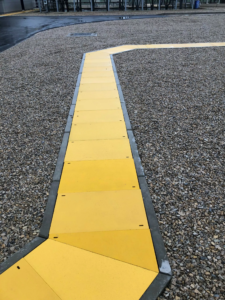When choosing grating materials, decision-makers often find themselves comparing traditional steel with innovative glass-reinforced plastic (GRP). Each has its strengths, but GRP is rapidly gaining traction for its unique benefits, especially in industrial and commercial settings. In this blog, we explore the differences between steel and GRP gratings, focusing on strength, durability, cost, and suitability for various environments.
The Strength of Steel and GRP
Steel has long been the standard for heavy-duty applications due to its high tensile strength and resilience. It’s often chosen for settings where extremely high loads are common. Forge-welded steel gratings, for example, are designed to handle substantial weight and endure rigorous conditions.
GRP gratings, however, offer a competitive level of strength, especially for medium-duty and certain heavy-duty applications. Built with a combination of fibreglass and resin, GRP can withstand significant weight and impact, making it suitable for industries like rail, utilities, and offshore oil and gas. Elemy meet stringent standards such as BS 4592 and EN 14122, ensuring dependable performance in demanding conditions.
Durability and Resistance to Corrosion
One of the greatest advantages of GRP is its resistance to corrosion, especially in harsh or corrosive environments. GRP does not rust, unlike steel, which requires costly maintenance or coating to protect it from moisture, chemicals, and salt. GRP’s inherent resistance to a variety of chemicals makes it particularly useful in industries like wastewater treatment and offshore facilities which often require gratings in corrosive environments. Galvanisation or other anti-corrosive treatments can prolong the life of steel gratings but this does add to both initial and maintenance costs. In contrast, GRP’s low maintenance requirements make it an attractive option for projects with long-term cost-saving goals.
Weight and Installation Ease
GRP gratings are up to 50% lighter than steel alternatives, a characteristic that simplifies handling, transportation, and installation. This can also reduce installation time and costs, especially for projects where lifting heavy materials would otherwise require special equipment.
Elemy offers an array of GRP products designed for easy installation, complete with custom sizing options and various colour choices. With Elemy’s GRP gratings, the installation process is not only faster but can be tailored to specific aesthetic and functional needs.
Cost Comparison
Although steel gratings tend to have a lower upfront cost, the total cost of ownership is often higher due to maintenance and replacement requirements over time. GRP, while slightly more expensive initially, provides cost savings through minimal upkeep, longevity, and its lower risk of corrosion and chemical damage.
For budget-conscious buyers considering long-term costs, GRP gratings from Elemy provide a smart investment. Elemy’s GRP gratings come with ISO 9001 certification, ensuring quality and durability that often surpass traditional options.
Elemy is committed to sustainable practices, offering GRP products manufactured with recycled content. Unlike steel, which requires energy-intensive processes to produce and maintain, GRP is a more eco-friendly choice that aligns with green building initiatives.
The overall benefits – why Elemy
Ultimately, the decision between steel and GRP gratings depends on the specific requirements of your project. For high-load, heavy-duty needs in non-corrosive environments, steel remains a robust choice. However, if you’re looking for a lightweight, corrosion-resistant, and low-maintenance material that’s ideal for outdoor and chemical-prone environments, GRP may fit the bill.
Explore Elemy’s full range of GRP gratings and discover the ideal solutions for your next project. Browse Elemy’s GRP Products to learn more about the benefits of GRP and find products tailored to your industry needs.

